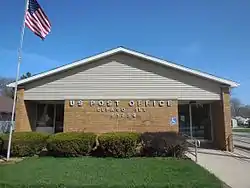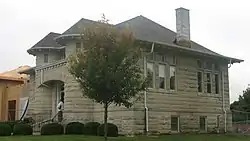El Paso, Illinois | |
|---|---|
 El Paso Post Office | |
 Location in Woodford County, Illinois | |
 Chenoa Location in the United States | |
| Coordinates: 40°44′26″N 89°01′06″W / 40.74056°N 89.01833°W | |
| Country | United States |
| State | Illinois |
| Counties | Woodford, McLean |
| Townships | El Paso, Gridley |
| Government | |
| • Mayor | JW Price |
| Area | |
| • Total | 2.15 sq mi (5.56 km2) |
| • Land | 2.15 sq mi (5.56 km2) |
| • Water | 0.00 sq mi (0.00 km2) |
| Elevation | 748 ft (228 m) |
| Population | |
| • Total | 2,756 |
| • Density | 1,284.85/sq mi (496.04/km2) |
| Time zone | UTC-6 (CST) |
| • Summer (DST) | UTC-5 (CDT) |
| ZIP code | 61738 |
| Area code | 309 |
| FIPS code | 17-23737 |
| FIPS code | 17-23737 |
| GNIS ID | 2394632[2] |
| Wikimedia Commons | El Paso, Illinois |
| Website | www |
El Paso is a city in Woodford and McLean counties in the U.S. state of Illinois. The population was 2,756 at the 2020 census.[3] The Woodford County portion of El Paso is part of the Peoria Metropolitan Statistical Area.
El Paso is a small community in central Illinois that took on more characteristics of a highway community after the construction of Interstate 39, which supplanted the older alignment of U.S. Highway 51.
History
El Paso was founded by George Gibson and James Wathen. Gibson gave it the Spanish name El Paso, either after El Paso, Texas,[4] or because of a nearby railroad junction.[5]
In August 1975, the city became the last locality in the contiguous United States to convert its telephone service from manual switching; prior to that time, telephones in the city could not be dialed directly from any outside location. The assistance of an operator was necessary to place the call, and local telephone numbers consisted of four digits. Parts of the outer Aleutian Islands in Alaska could not be dialed directly until the early 1980s.
Geography
El Paso is located in southeastern Woodford County at 40°44′20″N 89°0′58″W / 40.73889°N 89.01611°W (40.738800, -89.016034).[6] A small portion of the city limits extends east along U.S. Route 24 into northern McLean County. US 24 leads east 15 miles (24 km) to Interstate 55 in Chenoa and west 32 miles (51 km) to Peoria. Interstate 39 crosses the west side of El Paso, with access from Exit 14 (US 24); the Interstate highway leads south 14 miles (23 km) to Interstate 55 in Normal and north 45 miles (72 km) to La Salle. Illinois Route 251 follows the former alignment of U.S. Route 51 through the center of El Paso, leading north 11 miles (18 km) to Minonk and south 5 miles (8 km) to Kappa.
According to the U.S. Census Bureau, El Paso has a total area of 2.15 square miles (5.57 km2), all land.[1] The city sits on high ground that drains north to the East Branch of Panther Creek and south to the headwaters of Wolf Creek. Both creek systems are south-flowing tributaries of the Mackinaw River and part of the Illinois River watershed.
Demographics
| Census | Pop. | Note | %± |
|---|---|---|---|
| 1860 | 890 | — | |
| 1870 | 1,564 | 75.7% | |
| 1880 | 1,390 | −11.1% | |
| 1890 | 1,353 | −2.7% | |
| 1900 | 1,441 | 6.5% | |
| 1910 | 1,470 | 2.0% | |
| 1920 | 1,638 | 11.4% | |
| 1930 | 1,578 | −3.7% | |
| 1940 | 1,621 | 2.7% | |
| 1950 | 1,818 | 12.2% | |
| 1960 | 1,964 | 8.0% | |
| 1970 | 2,291 | 16.6% | |
| 1980 | 2,676 | 16.8% | |
| 1990 | 2,499 | −6.6% | |
| 2000 | 2,695 | 7.8% | |
| 2010 | 2,810 | 4.3% | |
| 2020 | 2,756 | −1.9% | |
| U.S. Decennial Census[7] | |||
As of the 2000 United States Census,[8] there were 2,695 people, 980 households, and 686 families residing in the city. The population density was 1,743.9 inhabitants per square mile (673.3/km2). There were 1,022 housing units at an average density of 661.3 per square mile (255.3/km2). The racial makeup of the city was 98.89% White, 0.15% African American, 0.15% Native American, 0.22% Asian, 0.22% from other races, and 0.37% from two or more races. Hispanic or Latino of any race were 0.71% of the population.
There were 980 households, out of which 35.9% had children under the age of 18 living with them, 57.9% were married couples living together, 8.6% had a female householder with no husband present, and 29.9% were non-families. 25.2% of all households were made up of individuals, and 13.1% had someone living alone who was 65 years of age or older. The average household size was 2.58 and the average family size was 3.12.
In the city, the population was spread out, with 26.6% under the age of 18, 8.6% from 18 to 24, 28.7% from 25 to 44, 19.8% from 45 to 64, and 16.3% who were 65 years of age or older. The median age was 36 years. For every 100 females, there were 92.1 males. For every 100 females age 18 and over, there were 87.7 males.
The median income for a household in the city was $47,745, and the median income for a family was $55,286. Males had a median income of $36,406 versus $25,174 for females. The per capita income for the city was $21,730. About 1.6% of families and 3.2% of the population were below the poverty line, including 2.1% of those under age 18 and 6.6% of those age 65 or over.
Culture

Attractions
- El Paso Public Library, a Carnegie library built in 1907[9]
- Archbishop Fulton John Sheen Spiritual Centre[10]
- El Paso Golf Club[11]
Notable people
- Chick Evans, college athletics coach; raised in El Paso[12]
- Byron Keith, actor, best known for recurring roles in Batman (TV series) and 77 Sunset Strip; born in El Paso
- Fulton J. Sheen, Catholic archbishop and televangelist; born in El Paso[13]
- Elsa Swartz, composer and music educator; born in El Paso
- Ryan Unzicker, racing driver; born in El Paso
- Clifford J. Vogelsang, Illinois state senator, judge, and lawyer; born in El Paso[14]
Education
El Paso's school district, CUSD #11,[15] is the product of a consolidation with the school district of Gridley, IL. CUSD #11's schools are split between El Paso and Gridley:[16]
- El Paso Gridley High School - Housing all of the high school students for the district
- El Paso Gridley Junior High School - Housing all of the upper and lower levels of junior high (grades 5, 6, 7, and 8) students for the district
- Centennial School - Housing all the grade 3 and 4 elementary students of the district
- Jefferson Park - Housing all the preschool, kindergarten, and grade 1 and 2 elementary students of the district
References
- 1 2 "2022 U.S. Gazetteer Files: Illinois". United States Census Bureau. Retrieved March 7, 2023.
- 1 2 U.S. Geological Survey Geographic Names Information System: El Paso, Illinois
- 1 2 "P1. Race – El Paso city, Illinois: 2020 DEC Redistricting Data (PL 94-171)". U.S. Census Bureau. Retrieved March 7, 2023.
- ↑ Illinois Central Magazine. Illinois Central Railroad Company. 1922. p. 43.
- ↑ Gannett, Henry (1905). The Origin of Certain Place Names in the United States. Govt. Print. Off. p. 118.
- ↑ "US Gazetteer files: 2010, 2000, and 1990". United States Census Bureau. February 12, 2011. Retrieved April 23, 2011.
- ↑ "Census of Population and Housing". Census.gov. Retrieved June 4, 2015.
- ↑ "U.S. Census website". United States Census Bureau. Retrieved January 31, 2008.
- ↑ "El Paso Public Library - National Register of Historic Places Registration Form" (PDF). June 29, 1994. Archived from the original (PDF) on October 5, 2016. Retrieved October 4, 2016.
- ↑ Vlahos, Nick. "Two museums tell the tale of Archbishop Fulton J. Sheen". Retrieved October 4, 2016.
- ↑ "El Paso Golf Club - Home Page". www.elpasogolfclub.com. Retrieved October 4, 2016.
- ↑ "George 'Chick' Evans Bio". Northern Illinois University. Retrieved March 5, 2020.
- ↑ Patricia A. Kossmann, "Remembering Fulton Sheen," America: The National Catholic Review, Dec. 6, 2004.
- ↑ 'Illinois Blue Book 1933-1934,' Biographical Sketch of Clifford J. Vogelsang, pg. 194-195, 219
- ↑ "El Paso - Gridley CUSD #11". www.unit11.org. Retrieved October 4, 2016.
- ↑ "District Information". www.unit11.org. Retrieved May 18, 2022.